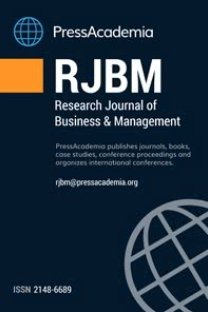DÖNÜŞÜMSEL LİDERLİK DAVRANIŞININ YÖNETİM İNOVASYONU ÜZERİNDEKİ ETKİSİ: TÜRKİYE’DE AMPİRİK BİR ARAŞTIRMA
Yönetim inovasyonu, inovasyon, dönüşümcü liderlik, liderlik, idari inovasyon
THE IMPACT OF TRANSFORMATIONAL LEADERSHIP ON MANAGEMENT INNOVATION: AN EMPIRICAL RESEARCH IN TURKEY
Management innovation, innovation, transformational leadership, Leadership, administrative innovation,
___
- Amabile, T. M. (1998). How to kill creativity. Harvard Business Review, 76, 76–87.
- Armbruster, H., Bikfalvi, A., Kinkel, S., & Lay, G. (2008). Organizational innovation: The challenge of measuring non-technical innovation in large-scale surveys. Technovation, 28, 644–657.
- Arrow, K. (1962). The economic implication of learning by doing. Review of Economic Studies, 29, 155–173.
- Avolio, B. J., Bass, B. M., & Jung, D. I. (1999). Re-examining the components of transformational and transactional leadership using the multifactor leadership questionnaire. Journal of Occupational and Organizational Psychology, 72, 441–462.
- Bass, B. M. (1985). Leadership: Good, better, best. Organizational Dynamics, 13(3), 26-40.
- Bass, B. M., Jung, D. I., Avolio, B. J., & Berson, Y. (2003). Predicting unit performance by assessing transformational and transactional leadership. Journal of Applied Psychology, 88, 207–218.
- Battisti, G., & Stoneman, P. (2010). How innovative are UK firms? Evidence from the Fourth UK Community Innovation Survey on synergies between technological and organizational innovations. British Journal of Management, 21, 187–206.
- Birkinshaw, J., Hamel, G., & Mol, M. (2008). Management innovation. Academy of Management Review, 33, 825–845.
- Burns, J. M. G. (1978). Leadership. New York: Harper & Row.
- Chandy, R. K., & Tellis, G. L. (2000). The incumbent’s curse? Incumbency, size, and radical product innovation. Journal of Marketing, 64, 1– 17.
- CIS (2012). http://www.tuik.gov.tr (bilgi edinme kapsamında anket formuna ulaşılmıştır).
- Damanpour, F. (2014). Footnotes to research on management innovation. Organization Studies, 35(9), 1265-1285.
- Damanpour, F., & Aravind, D. (2012). Managerial innovation: Conceptions, processes, and antecedents. Management and Organization Review, 8, 423–454.
- Evangelista, R., & Vezzani, A. (2010). The economic impact of technological and organizational innovations: A firm level analysis. Research Policy, 39, 1253–1263.
- Hamel, G. (2006). The why, what and how of management innovation. Harvard Business Review, 84(2), 72–84.
- Johnson, S. (2010). Where good ideas come from: The natural history of innovation. New York: Riverhead Books.
- Jung, D. I., Chow, C., & Wu, A. (2003). The role of transformational leadership in enhancing organizational innovation: hypotheses and some preliminary findings. Leadership Quarterly, 14, 525–544.
- Kimberly, J. R. (1981). Managerial innovation. In P. C. Nystrom and W. H. Starbuck (Eds.), Handbook of organizational design (ss. 84–104). New York, NY: Oxford University Press.
- Mendes, C. (1981). http://www.atam.gov.tr/dergi/sayi-02/ataturk-ve-liderlik (Erişim tarihi: 16.03.2016).
- Nelson, R. R. (1991). Why do firms differ, and how does it matter? Strategic Management Journal, 12, 61–74.
- Nieves, N., & Segarra-Cipres, M. (2015). Management innovation in the hotel industry. Tourism Management, 46, 51-58.
- OECD (2005). Oslo Manual: The measurement of scientific and technological activities. Paris: OECD.
- Sanidas, E. (2005). Organizational innovations and economic growth: Organosis and growth of firms, sectors, and countries. Cheltenham, UK: Edward Elgar.
- Schumpeter, J. A. (1934/1911). The theory of economic development. Cambridge, MA: Harvard University Press.
- Schumpeter, J. A. (1942). Capitalism, socialism and democracy. New York, NY: Harper.
- Sosik, J. J. (1997). Effects of transformational leadership and anonymity on idea generation in computermediated groups. Group and Organization Management, 22, 460–487.
- Vaccaro, I. G., Jansen, J. J. P., Van Den Bosch, F. A. J., & Volberda, H. W. (2012). Management Innovation and Leadership: The moderating role of organizational size. Journal of Management Studies, 49(1), 28-51.
- Walker, R. M., Damanpour, F., & Devece, C. A. (2011). Management innovation and organizational performance: Mediating role of planning and control. Journal of Public Administration Research and Theory, 21, 367–386.
- Werner, I. (1993). Liderlik ve Yönetim (Çev. Vedat Üner). İstanbul: Rota Yayınevi.
- Whittington, R., Pettigrew, A., Peck, S., Fenton, F., & Conyon, M. (1999). Change and complementarities in the new competitive landscape: A European panel study, 1992–1996. Organization Science, 10, 583–600.
- Zhou, J., & George, J. M. (2003). Awakening employee creativity: The role of leader emotional intelligence’. Leadership Quarterly, 14, 545– 568.
- Yayın Aralığı: Yılda 4 Sayı
- Başlangıç: 2014
- Yayıncı: PressAcademia
Mustafa Demirkiran, Mehmet Yorulmaz, Sultan UNA, Serap Taskaya
Indrianty Sudirman, Indahwaty Sidin
PATERNALİST LİDERLİĞİN ÖRGÜTSEL ÖZDEŞLEŞME ÜZERİNE ETKİSİ: LİDERE GÜVENİN ARACILIK ROLÜ
Nurcan Ciraklar, Zeki Ucar, Oytun Sezgin
Kamaludin KAMALUDİN, Berto USMAN
YARATICI SINIFIN ŞEHİRLERDE YAŞAM VE İŞ YERİ TERCİHLERİ: İSTANBUL ÖRNEĞİ
